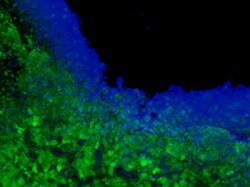 |
| Cytotoxins attacking brain tumor cells--Courtesy of Harvard U. |
Researchers at Harvard have programmed stem cells embedded in a mouse tumor to deliver a toxic dose of cytotoxins, killing the cancer cells from the inside. The research was published in the journal Stem Cells.
Cytotoxins are very effective at killing cells, but because of that toxicity they aren't exactly safe when injected into a tumor outright. To make them more specific in their delivery, the researchers at Harvard's Stem Cell Institute have engineered the cells to constantly release small amounts of the toxin over a long period of time. Multiple mutations in the cell's genetic material allow it to both make the toxin and survive in its presence, as shown in a study in mice with brain cancer.
The toxins themselves are tagged to target either epidermal growth factor receptors or interleukin-13 receptor alpha 2, both commonly found in brain tumors, according to an article in Popular Science. The stem cells were placed in the tumors after surgery using a biodegradable gel, and they released their toxins to increase the overall survival of the mice.
"A few years ago we recognized that stem cells could be used to continuously deliver these therapeutic toxins to tumors in the brain, but first we needed to genetically engineer stem cells that could resist being killed themselves by the toxins," lead author Khalid Shah said in a Harvard release. "Now, we have toxin-resistant stem cells that can make and release cancer-killing drugs."
The team is pursuing FDA approval for the stem cell approach. Previously, the scientists have used stem cells to deliver the herpesvirus to cancer cells, also killing them, but the cytotoxins are in theory a more effective way to make that happen.
- get the research abstract
- here's the Harvard report
- and here's the Popular Science article